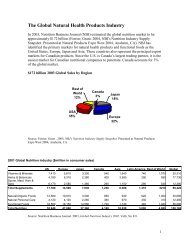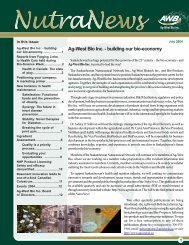Beyond Borders: Global biotechnology report 2010
Beyond Borders: Global biotechnology report 2010
Beyond Borders: Global biotechnology report 2010
Create successful ePaper yourself
Turn your PDF publications into a flip-book with our unique Google optimized e-Paper software.
Products and pipeline<br />
Steady growth<br />
In many ways, 2009 looked much like<br />
2008 in terms of product and pipeline<br />
developments. The US Food and Drug<br />
Administration (FDA) approved 29 new<br />
molecular entities (NMEs) and biologic<br />
license applications (BLAs) — about<br />
the same number as in 2008, when<br />
27 were approved. Approvals by the<br />
European Medicines Agency (EMA) also<br />
remained relatively flat. The number of<br />
drug candidates in the clinical pipelines<br />
of European companies increased by<br />
16% during the year — also on par with<br />
the growth seen in recent years. Phase<br />
II programs led the growth, with a 22%<br />
increase over 2008.<br />
United States<br />
Approvals: steady progress<br />
After years of insufficient staffing levels,<br />
the FDA launched a hiring initiative in<br />
2008 to increase headcount by 1,300 new<br />
employees. The FDA was increasing staffing<br />
levels not only to improve the percentage<br />
of reviews in which it meets priority and<br />
standard review deadlines — which according<br />
to a study in Nature were 69% and 83% in<br />
2009, respectively — but also to meet its<br />
responsibility to regulate tobacco starting in<br />
June 2009. However, 2009 was also a year<br />
with a massive pandemic scare that required<br />
regulatory agencies to respond rapidly with<br />
fast-track approval for an H1N1 vaccine.<br />
Also, a lag time exists between the time a<br />
new employee joins the FDA and comes fully<br />
up to speed in a way that could impact the<br />
overall performance goal of meeting 90%<br />
of the priority and standard review times.<br />
Considering those factors, there is reason to<br />
hope that the hiring increase could translate<br />
into faster approval times in years ahead.<br />
After reaching an all-time low in 2007, FDA<br />
drug approval numbers have rebounded<br />
slightly in 2008 and 2009. In 2009,<br />
the FDA approved 29 new products,<br />
including 25 NMEs and BLAs approved<br />
by the Center for Drug Evaluation and<br />
Research (CDER) and four BLAs approved<br />
by the Center for Biologics Evaluation and<br />
Research (CBER). (These totals do not<br />
include vaccines approved by CDER or<br />
CBER.) Products granted approval in 2009<br />
were in therapeutic categories that have<br />
traditionally led product approvals, including<br />
five approvals in cancer and four approvals<br />
for neurological disorders.<br />
A number of the products approved were<br />
developed by US <strong>biotechnology</strong> companies.<br />
For instance, in the case of Fanapt, approved<br />
in May 2009 for the treatment of<br />
schizophrenia, Novartis acquired the US<br />
and Canadian commercialization rights<br />
from Vanda Pharmaceuticals in October.<br />
The drug had previously changed hands<br />
numerous times. (For more details, refer to<br />
the Deals article.) In June, AMAG gained<br />
marketing approval for Feraheme, its<br />
treatment of iron deficiency anemia (IDA) in<br />
adult patients with chronic kidney disease.<br />
Before approving it in 2009, the FDA<br />
had twice delayed Feraheme (in October<br />
2008, through a complete response letter<br />
requesting additional clinical information<br />
and the addressing of certain manufacturing<br />
deficiencies, and again in December 2008).<br />
The second half of the year was very<br />
productive for biotech company approvals.<br />
In September, Ista Pharmaceuticals’<br />
ophthalmic solution, Bepreve, was<br />
approved for ocular itching associated with<br />
allergic conjunctivitis. That same month,<br />
Allos Therapeutics gained approval for<br />
its relapsed peripheral T-cell lymphoma<br />
86 <strong>Beyond</strong> borders <strong>Global</strong> <strong>biotechnology</strong> <strong>report</strong> <strong>2010</strong><br />
therapy, Folotyn, while Theravance gained<br />
approval for its treatment of complicated<br />
skin and skin structure infections (cSSSIs),<br />
Vibativ. In November, Dyax Corporation<br />
received FDA approval for its drug<br />
Kalbitor — a competing product to Lev<br />
Pharmaceuticals’ 2008 approved product,<br />
Cinryze — for sudden attacks of hereditary<br />
angioedema (HAE).<br />
Success: pipeline surprises<br />
Two biotech companies, Dendreon and<br />
Human Genome Sciences, received positive,<br />
late-stage clinical results for their drug<br />
candidates that resulted in sharp upticks in<br />
their stock performance in 2009. (See this<br />
year’s financing article, “A higher bar,” for<br />
more information).<br />
The FDA had initially rejected Dendreon’s<br />
Provenge in 2007 because of insufficient<br />
clinical data. This experimental prostate<br />
cancer therapy is designed to activate a<br />
patient’s own immune system by taking<br />
cells from a patient’s tumor, incorporating<br />
them into a vaccine and injecting the cells<br />
back into the patient to elicit an immune<br />
response. The rejection was issued despite<br />
an overwhelming recommendation from<br />
an outside advisory panel for the drug’s<br />
approval. With patients left with limited<br />
choices for advanced prostate cancer that<br />
has spread outside the prostate gland,<br />
Dendreon continued work on Provenge and<br />
completed an additional Phase III study.<br />
In April 2009, Dendreon announced the<br />
results of the study, which demonstrated<br />
median survival rates had been extended<br />
by about four months. The positive news<br />
gave the company a major boost with<br />
investors, as its market value skyrocketed<br />
from US$440 million (US$4.62/share) at








